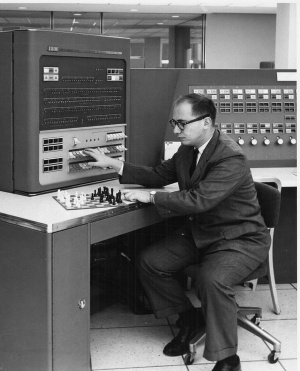The Bernstein Chess Program
Home * Engines * The Bernstein Chess Program
The Bernstein Chess Program,
was the first complete chess program, developed around 1957 at Service Bureau Corporation, Madison & 59th Street, Manhattan, New York City [2], by chess player and programmer at IBM, Alex Bernstein with his colleagues Michael de V. Roberts, Timothy Arbuckle and Martin Belsky, supported by chess advisor Arthur Bisguier [3], who became IBM employee at that time and in 1957 international chess grandmaster, and supervised by Nathaniel Rochester [4].
Quote
As mentioned by John McCarthy [5], the Bernstein Chess Program under construction was presented at the 1956 Dartmouth workshop:
Alex Bernstein of IBM presented his chess program under construction. My reaction was to invent and recommend to him alpha-beta pruning. He was unconvinced.
Shannon Type B
The Bernstein Chess Program was the prototype of a selective forward pruning, Shannon Type B program. On an IBM 704, one of the last vacuum tube computers, it searched four plies minimax in around 8 minutes, considering seven most plausible moves from each position and evaluated material, mobility, area control and king defense [6].
Publications
- Alex Bernstein, Michael de V. Roberts (1958). Computer vs. Chess-Player. Scientific American, Vol. 198, reprinted 1988 in Computer Chess Compendium
- Alex Bernstein (1958). A Chess Playing Program for the IBM 704. Chess Review, July 1958
- Alex Bernstein, Michael de V. Roberts, Timothy Arbuckle, Martin Belsky (1958). A chess playing program for the IBM 704. Proceedings of the 1958 Western Joint Computer Conference
- Fritz Leiber (1962). The 64-Square Madhouse. Worlds of If [8]
External Links
- Alex Bernstein from The Computer History Museum
- Classic Computer Chess - ... The programs of yesteryear by Carey, hosted by the Internet Archive [9]
- Photos by Andreas Feininger, Getty Images
- Chess Pieces - IBM Research the Deep Blue site
- Runner-Up - The New Yorker - November 29, 1958
- Alex Bernstein: juega al ajedrez con un IBM 704 (Thinking Machines), YouTube Video
References
- ↑ IBM programmer Alex Bernstein 1958 Courtesy of IBM Archives from The Computer History Museum
- ↑ Runner-Up - The New Yorker - November 29, 1958
- ↑ Arthur Bisguier from Wikipedia.de (German)
- ↑ Nathaniel Rochester (computer scientist) from Wikipedia
- ↑ The Dartmouth Workshop--as planned and as it happened
- ↑ Alex Bernstein, Michael de V. Roberts (1958). Computer vs. Chess-Player. Scientific American, Vol. 198, reprinted 1988 in Computer Chess Compendium
- ↑ hosted by The Computer History Museum
- ↑ Fritz Leiber's "The 64-Square Madhouse" by Ian Osgood, CCC, October 28, 2013
- ↑ Re: Old programs CHAOS and USC by Dann Corbit, CCC, July 11, 2015
